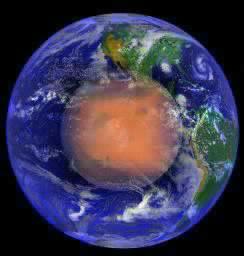
Cydonia Quest C D&M Pyramid - Examining the "Girders" C Part One
This page contains some very large images. Readers are advised to view this page in "full screen" mode to fit more of each image onto the screen at the same time. Press the F11 key to enter "full screen" and then F11 again to return to the normal browser view.
Some readers will also benefit by increasing their browser "zoom" by an increment - hold down the control key (Ctrl) and press the plus key (+). To return to standard zoom hold down the control key and press the minus key (-). For tips about adjusting the appearance of your browser display click here.
Viewing the images in low lighting conditions also makes details easier to see. C After the "Face on Mars" the D&M Pyramid is the second best known anomaly in the Cydonia region of Mars. It is named after its discoverers, the NASA imaging specialists Vincent DiPietro and Gregory Molenaar. The D&M Pyramid attracted attention because of its regular looking geometric qualities and close proximity to the "Face".
The D&M is a two mile long, five sided pyramid. It is symmetrical around its longest access, but its floorplan is an elongated rather than a regular pentagon. The existence of an isolated buttress in its eastern facet actually creates a second symmetrical pentagon pattern that is rotated to the floorplan pentagon by around 19.5 degrees. The 19.5 degree angle is special to tetrahedral geometry, which seems to be a feature of the positioning of the many anomalous mounds in Cydonia.
The shapes of both pentagons within the D&M layout yield significant geometrical relationships that would be more usually associated with playfully designed architecture on Earth.
There already exists a three part Cydonia Quest investigation into the D&M Pyramid's geometric qualities. For a more detailed analysis of the geometry of the D&M Pyramid click this "stargate" µµµ.
The large display poster below provides a "taster" for some of the geometry outlined by the D&M's floorplan and five facets.
This text continues after the poster.
According to a theory first espoused by Richard C.Hoagland, the D&M Pyramid is more than just a Giza style artificial monument - it is the heavily eroded and collapsed ruins of an incredibly ancient arcology. Arcologies are massive (self contained) habitations that can house substantial populations. They are effectively a town or a city contained in a single building and were first designed seriously by the architect Paolo Soleri. They are particularly suitable habitations for harsher planetary surfaces than Earth's. (However, the arcology may have first been imagined by H.G. Wells in "The Town in One Building", which was published in 1899 and formed part of a serialisation called "The Sleeper Awakes". See µµµ).
The image below shows the concept for a colossal steel and glass arcology proposed for the Persian Gulf state of Dubai.
Hoagland uses the term "looking for the girders" as shorthand for examining the surfaces of the anomalous mounds in Cydonia for evidence of small scale constructional features showing through their rubble. If the D&M and other large mounds in Cydonia are arcologies then we would expect some evidence of the walls, living space and support structures that would be part of their architecture.
Near the end of 2015 the team responsible for the HiRISE camera onboard the Mars Reconnaissance Observer spacecraft published two high resolution images of the D&M Pyramid. The main image, taken almost directly from above, was at a resolution of 30 centimetres (one foot) per image pixel, (see µµµ). The supplementary image was taken at an oblique angle at a resolution of 69 centimetres per image pixel, (see µµµ) .
The following web pages in this article use the 30 centimetre resolution image of the D&M to show that there is extensive evidence of ruined structural details on the crumbling surface of the pyramid. Therefore, the D&M Pyramid's geometry is not the only indication for it being the ruin of an incredibly ancient arcology.
A larger version of the header image that begins this page can be viewed by clicking on this "stargate" µµµ. If the reader owns a pair of red/blue glasses for viewing 3D images then they might also enjoy the following stereo image created out of the 30 centimetre and 69 centimetre resolution images µµµ.
Click the links below to continue reading this article. C
µ Forward to Part 2 µ Forward to Part 3 µ Forward to Part 4 µ Forward to Part 5 µ Back to the Mars Page µ Back to Cydonia Quest Main Page C
|



